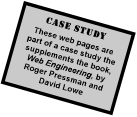

Case Study - Overview
Web Engineering:
A Practitioners Approach
Roger Pressman, David Lowe
This website is a partial prototype of the fictional SafeHome Products application - a case study developed to support the book: Web Engineering: A Practitioners Approach, written by Roger Pressman and David Lowe.
The website prototype is only a partial implementation, and aims to illustrate the main components of the site and some of the design elements. On each of the prototype pages there is a link in the top right corner which, when clicked, provides some additional information regarding the design of that page.
Note: Where the real WebApp would contain a link, but in this prototype the link isn't implemented, it will be shown with a dotted underline.
Dummy Link
This website is only a partial prototype of the fictional SafeHome Products application. As such this link is not yet operational. Non-operational links are shown with a dotted underline.
|
||
|
Bonus Information
As each WebApp increment is introduced, a questionnaire containing the questions posed above could be provided to a representative set of end-users. Where appropriate, the questions could be customized to suit the particular WebApp being developed. Once the answers are statistically analyzed, the results can provide the WebE team with an indication of user-centric perceptions of design (and construction) quality.
|